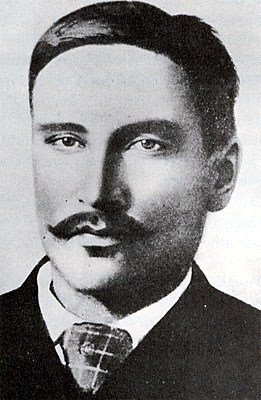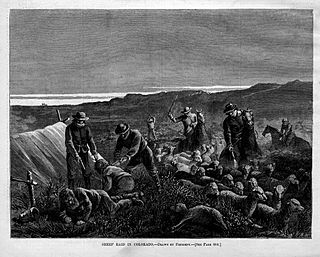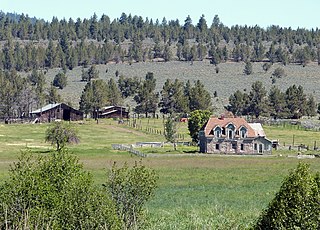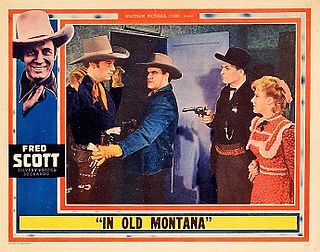
The Johnson County War, also known as the War on Powder River and the Wyoming Range War, was a range conflict that took place in Johnson County, Wyoming from 1889 to 1893. The conflict began when cattle companies started ruthlessly persecuting alleged rustlers in the area, many of whom were settlers who competed with them for livestock, land and water rights. As violence swelled between the large established ranchers and the smaller settlers in the state, it culminated in the Powder River Country when the former hired gunmen to invade the county. The gunmen's initial incursion in the territory alerted the small farmers and ranchers, as well as the state lawmen, and they formed a posse of 200 men that led to a grueling stand-off. The siege ended when the United States Cavalry on the orders of President Benjamin Harrison relieved the two forces, although further fighting persisted in the following months.

Centennial is a novel by American author James A. Michener, published in 1974. It traces the history of the plains of north-east Colorado from prehistory until the mid-1970s. Geographic details about the fictional town of Centennial and its surroundings indicate that the region is in modern Weld County.

Thomas Horn Jr., was an American scout, cowboy, soldier, range detective, and Pinkerton agent in the 19th-century and early 20th-century American Old West. Believed to have committed 17 killings as a hired gunman throughout the West, Horn was convicted in 1902 of the murder of 14-year-old Willie Nickell near Iron Mountain, Wyoming. Willie was the son of sheep rancher Kels Nickell, who had been involved in a range feud with neighbor and cattle rancher Jim Miller. On the day before his 43rd birthday, Horn was executed by hanging in Cheyenne, Wyoming.

Nathan D. Champion — known as Nate Champion — was a key figure in the Johnson County War of April 1892. Falsely accused by a wealthy Wyoming cattlemen's association of being a rustler, Champion was the first person targeted by a band of hit men hired by the cattlemen. In reality, Champion was simply a small rancher who stood up against the big cattlemen's practice of claiming all unbranded young cattle on the range. He is celebrated for his heroic stand in his besieged cabin and for a heartfelt letter written at the time describing the events.

The Colorado War was an Indian War fought in 1864 and 1865 between the Southern Cheyenne, Arapaho, and allied Brulé and Oglala Sioux peoples versus the U.S. army, Colorado militia, and white settlers in Colorado Territory and adjacent regions. The Kiowa and the Comanche played a minor role in actions that occurred in the southern part of the Territory along the Arkansas River. The Cheyenne, Arapaho, and Sioux played the major role in actions that occurred north of the Arkansas River and along the South Platte River, the Great Platte River Road, and the eastern portion of the Overland Trail. The United States government and Colorado Territory authorities participated through the 1st Colorado Cavalry Regiment, often called the Colorado volunteers. The war was centered on the Colorado Eastern Plains, extending eastward into Kansas and Nebraska.
A range war or range conflict is a type of usually violent conflict, most commonly in the 19th and early 20th centuries in the American West. The subject of these conflicts was control of "open range", or range land freely used for cattle grazing, which gave the conflict its name. Typically they were disputes over water rights or grazing rights and cattle ownership.

The Pleasant Valley War, sometimes called the Tonto Basin Feud, or Tonto Basin War, or Tewksbury-Graham Feud, was a range war fought in Pleasant Valley, Arizona in the years 1882–1892. The conflict involved two feuding families, the Grahams and the Tewksburys. The Grahams were ranchers, while the Tewksburys, who were part Native American, started their operations as cattle ranchers before branching out to sheep.

Ellen Liddy Watson was a pioneer of Wyoming who became known as Cattle Kate, an outlaw of the Old West, although the characterization is a dubious one, as subsequent research has tended to see her as a much maligned victim of a self-styled land baron. Watson had acquired homestead rights on land with water resources vital to the wealthiest rancher in the county, Albert Bothwell, when she was accused by him of cattle rustling. She was abducted from her home and lynched along with her husband by Bothwell and some other ranchers he had incited against her. The bodies were left hanging for two days, and the reputation that attached to her until recently was quickly established by newspaper publicity. Accounts of Watson as a rustler are now regarded as highly biased. Her life has become an Old West legend and inspired a number of television and film accounts.

Sundown Slim is a 1920 American silent Western film starring Harry Carey.

Heaven with a Gun is a 1969 American Western film starring Glenn Ford and directed by Lee H. Katzin.

The TA Ranch was the site of the principal events of the Johnson County Range War in 1892. The TA was established in 1882 as one of the first ranches in Johnson County, Wyoming. The TA is the only intact site associated with the range war, with trenches used by both sides still visible and scars on the nearby buildings. The ranch also documents the expansion and development of cattle ranching in Wyoming.

Jackson Lee "Diamondfield Jack" Davis was pardoned for the 1896 Deep Creek Murders in Idaho and would later strike it rich in Nevada, where he established several mining towns, one named after his nickname "Diamondfield".
Farthing, later re-named Iron Mountain, was a small, rural town in Laramie County Wyoming, formerly located southwest of Chugwater in the Chugwater Creek valley. The land where it once stood is now privately owned, part of an extensive ranch.

Empire Ranch is a working cattle ranch in southeastern Pima County, Arizona, that was placed on the National Register of Historic Places in 1976. In its heyday, Empire Ranch was one of the largest in Arizona, with a range spanning over 180 square miles (470 km2), and its owner, Walter L. Vail, was an important figure in the establishment of southern Arizona's cattle industry.

The sheep wars, or the sheep and cattle wars, were a series of armed conflicts in the Western United States which were fought between sheepmen and cattlemen over grazing rights. Sheep wars occurred in many western states though they were most common in Texas, Arizona and the border region of Wyoming and Colorado. Generally, the cattlemen saw the sheepherders as invaders, who destroyed the public grazing lands, which they had to share on a first-come, first-served basis. Between 1870 and 1920, approximately 120 engagements occurred in eight different states or territories. At least 54 men were killed and some 50,000 to over 100,000 sheep were slaughtered.

The Sheepshooters' War was an armed conflict fought in central and eastern Oregon. Like other range wars in the Old West, the war pitted cattlemen against sheepherders. Because the cattlemen were unwilling to share the open range with the sheepherders, due to concerns about overgrazing, they formed paramilitary organizations with the goal of eliminating the flocks of sheep and anyone who attempted to stop them. Between 1895 and 1906, the Sheepshooters, as they were called, slaughtered at least 25,000 sheep. A few men were also killed during gunfights or related incidents.

The Deep Creek murders were the culmination of a minor sheep war in the borderlands of Idaho and Nevada in 1896. On or about February 4, 1896, two Mormon sheepherders were killed by an unknown assailant while they were camping along a creek in what was then part of Cassia County, Idaho.

The Roba Ranch is a pioneer ranch located near the small unincorporated community of Paulina in Crook County, Oregon. The ranch is named for George and Mary Roba, sheep ranchers who acquired the property in 1892. Most of the important ranch buildings were constructed by the Roba family between about 1892 and 1910. Today, the ranch covers 1,480 acres (6.0 km2) and is privately owned. The ranch was listed on the National Register of Historic Places in 2007.

In Old Montana is a 1939 American Western film directed by Raymond K. Johnson and starring Fred Scott, Jean Carmen and John Merton. It is about the conflict existing between sheepherders and cattlemen in the nineteenth century.

William Walter Brown was an American pioneer rancher in central Oregon. He owned two large ranches between Burns and Prineville, Oregon. Together, his properties comprised one of the largest privately owned sheep and horse operations in the United States. He was known as the Horse King of the West and the Millionaire Horse King because over 10,000 horses carried his Horseshoe Bar brand. Brown was also a well-known philanthropist who gave hundreds of thousands of dollars to a wide range of religious and educational institutions.

















